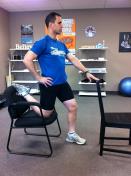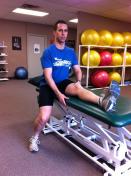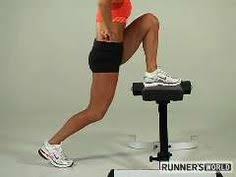
18 Sep A Running Program
Part 3: The Stretching Program
 This is no longer a “pre-season” program, so I will rename it simply a running stretching program. I always recommend a stretching program for any runner. This allows you to at least partially counteract the muscle imbalances and tightness that come from being a runner. These imbalances can be even more pronounced if you are a runner who sits at a desk all day (see my previous blog on this topic). The following stretches are pretty basic and aim to stretch the main muscle groups of the lower body: calf, quads, hamstrings, gluts and hip flexors. They include stretches that are given at our clinic on almost a daily basis.
This is no longer a “pre-season” program, so I will rename it simply a running stretching program. I always recommend a stretching program for any runner. This allows you to at least partially counteract the muscle imbalances and tightness that come from being a runner. These imbalances can be even more pronounced if you are a runner who sits at a desk all day (see my previous blog on this topic). The following stretches are pretty basic and aim to stretch the main muscle groups of the lower body: calf, quads, hamstrings, gluts and hip flexors. They include stretches that are given at our clinic on almost a daily basis.

1. Calf Stretches: the important thing about doing calf stretches is that you do them both with the knee bent as well as straight to be sure you get the two main muscle groups of the calf. If you are doing both these positions, it really doesn’t matter whether you do them with your foot against the wall (targeting plantar fascia a bit more), over a step or in a lunge against the wall (as shown).
 2. Hamstring Stretches: We prefer these hamstring stretches since they allow you to target different portions of the hamstring (medial and lateral) and give your knee a bit of protection since it is supported, but again whatever stretches work the best for you are fine. Sitting on a supportive structure (bench, couch or bed will do) first lean forward with a straight back (left image). Second, turn your shoulders away from the leg you are stretching and lean the same shoulder toward your knee still keeping your back as straight as possible (right image).
2. Hamstring Stretches: We prefer these hamstring stretches since they allow you to target different portions of the hamstring (medial and lateral) and give your knee a bit of protection since it is supported, but again whatever stretches work the best for you are fine. Sitting on a supportive structure (bench, couch or bed will do) first lean forward with a straight back (left image). Second, turn your shoulders away from the leg you are stretching and lean the same shoulder toward your knee still keeping your back as straight as possible (right image).

3: Quadriceps Stretches: We give this quad stretch out very regularly since the traditional quad stretch doesn’t target the rectus femorus (also a hip flexor).When the rectus femorus is tight it can effect your hips and back as well as your knee.
Standing with one knee on a chair behind you, and holding onto someting stand up as straight as you can until you feel the stretch in the front of the quad. Back of a couch or arm of a chair can also be used to prop the foot up.
4. Hip flexor Stretch: A favourite of Richard, this stretch targets
the hip flexor without putting too much strain on the back. Putting one foot on a higher structure like a table or railing, lunge forward until you feel the stretch at the hip of the standing leg.
5: Gluteus Maximus Stretch: Holding on to your leg in the crossed over position hig the knee in to your opposite shoulder and hold.
 6: Gluteus Minimus (and other small, deep hip external rotators) Stretch. this is my favorite stretch! Since starting Fascial Stretch Therapy, I have given this stretch out a lot as it is the closest I can get to mimicking the deep hip stretch that I give. Sitting in this position and keeping both hip bones on the floor let your knees fall to both sides to target specific muscles.
6: Gluteus Minimus (and other small, deep hip external rotators) Stretch. this is my favorite stretch! Since starting Fascial Stretch Therapy, I have given this stretch out a lot as it is the closest I can get to mimicking the deep hip stretch that I give. Sitting in this position and keeping both hip bones on the floor let your knees fall to both sides to target specific muscles.
To actually increase muscle length, stretches are best done when the core temperature is slightly raised (after activity) and should be held for a minimum of 30 seconds (as opposed to dynamic stretches which are done as pre-activity preparation), but any time is better than none. I find myself cutting them out after a run to save time, but will do them before bed as a relaxation technique… Do whatever works for you!
Remember, stretches alone might help reduce injury but will rarely help you recover on their own. See my previous blogs on running injuries, running strengthening, and eccentrics to give you more clues!
As always, thanks for reading!
Rebecca Chambers, MSc in Exercise Science and BSc(PT)
Photos courtesy of google images





No Comments